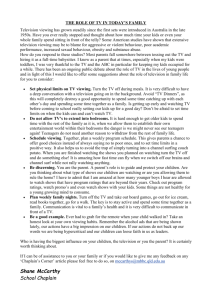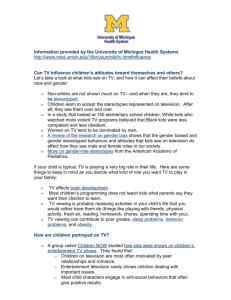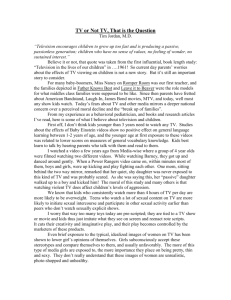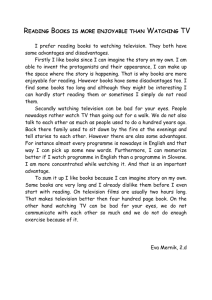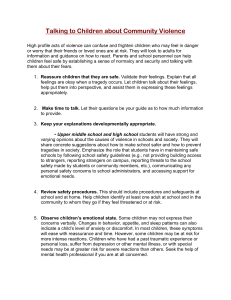Television and children
advertisement
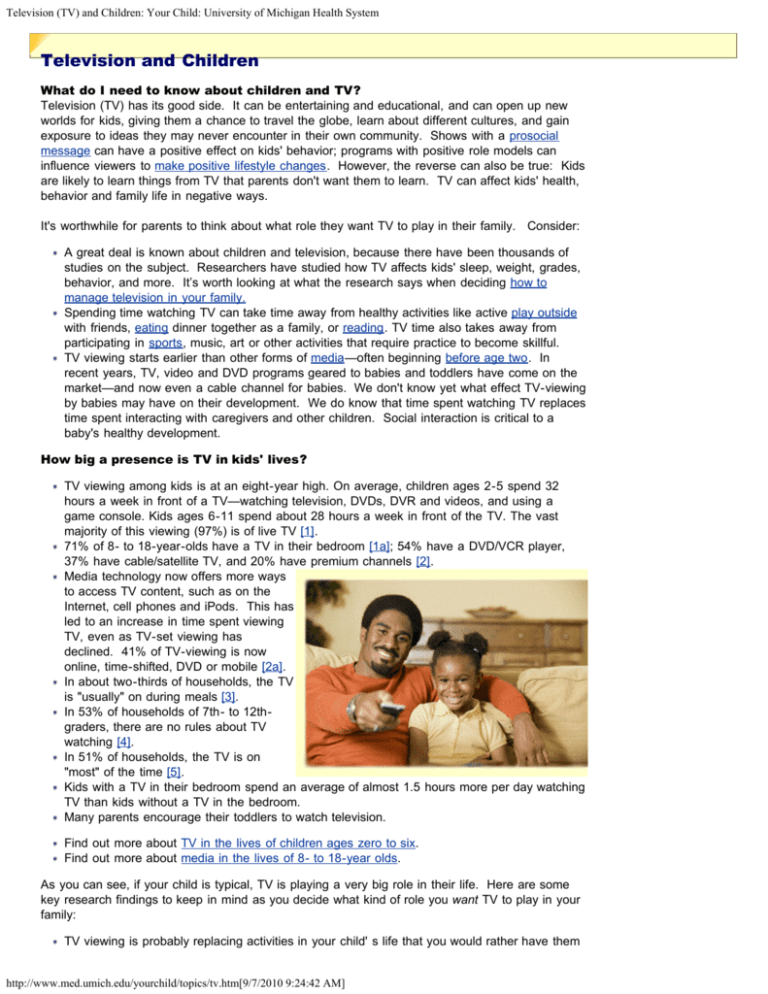
Television (TV) and Children: Your Child: University of Michigan Health System Television and Children What do I need to know about children and TV? Television (TV) has its good side. It can be entertaining and educational, and can open up new worlds for kids, giving them a chance to travel the globe, learn about different cultures, and gain exposure to ideas they may never encounter in their own community. Shows with a prosocial message can have a positive effect on kids' behavior; programs with positive role models can influence viewers to make positive lifestyle changes. However, the reverse can also be true: Kids are likely to learn things from TV that parents don't want them to learn. TV can affect kids' health, behavior and family life in negative ways. It's worthwhile for parents to think about what role they want TV to play in their family. Consider: A great deal is known about children and television, because there have been thousands of studies on the subject. Researchers have studied how TV affects kids' sleep, weight, grades, behavior, and more. It’s worth looking at what the research says when deciding how to manage television in your family. Spending time watching TV can take time away from healthy activities like active play outside with friends, eating dinner together as a family, or reading. TV time also takes away from participating in sports, music, art or other activities that require practice to become skillful. TV viewing starts earlier than other forms of media—often beginning before age two. In recent years, TV, video and DVD programs geared to babies and toddlers have come on the market—and now even a cable channel for babies. We don't know yet what effect TV-viewing by babies may have on their development. We do know that time spent watching TV replaces time spent interacting with caregivers and other children. Social interaction is critical to a baby's healthy development. How big a presence is TV in kids' lives? TV viewing among kids is at an eight-year high. On average, children ages 2-5 spend 32 hours a week in front of a TV—watching television, DVDs, DVR and videos, and using a game console. Kids ages 6-11 spend about 28 hours a week in front of the TV. The vast majority of this viewing (97%) is of live TV [1]. 71% of 8- to 18-year-olds have a TV in their bedroom [1a]; 54% have a DVD/VCR player, 37% have cable/satellite TV, and 20% have premium channels [2]. Media technology now offers more ways to access TV content, such as on the Internet, cell phones and iPods. This has led to an increase in time spent viewing TV, even as TV-set viewing has declined. 41% of TV-viewing is now online, time-shifted, DVD or mobile [2a]. In about two-thirds of households, the TV is "usually" on during meals [3]. In 53% of households of 7th- to 12thgraders, there are no rules about TV watching [4]. In 51% of households, the TV is on "most" of the time [5]. Kids with a TV in their bedroom spend an average of almost 1.5 hours more per day watching TV than kids without a TV in the bedroom. Many parents encourage their toddlers to watch television. Find out more about TV in the lives of children ages zero to six. Find out more about media in the lives of 8- to 18-year olds. As you can see, if your child is typical, TV is playing a very big role in their life. Here are some key research findings to keep in mind as you decide what kind of role you want TV to play in your family: TV viewing is probably replacing activities in your child' s life that you would rather have them http://www.med.umich.edu/yourchild/topics/tv.htm[9/7/2010 9:24:42 AM] Television (TV) and Children: Your Child: University of Michigan Health System do (things like playing with friends [6] , being physically active, getting fresh air, reading, playing imaginatively, doing homework [7], doing chores). Kids who spend more time watching TV (both with and without parents and siblings present) spend less time interacting with family members. [8] Excessive TV viewing can contribute to poor grades [8a], sleep problems, behavior problems, obesity, and risky behavior. Most children’s programming does not teach what parents say they want their children to learn; many shows are filled with stereotypes, violent solutions to problems, and mean behavior. Advertisers target kids, and on average, children see tens of thousands of TV commercials each year [9]. This includes many ads for unhealthy snack foods and drinks. Children and youth see, on average, about 2,000 beer and wine ads on TV each year [10]. Kids see favorite characters smoking, drinking, and involved in sexual situations and other risky behaviors in the shows and movies they watch on TV. More on how television viewing affects children. For more detailed information on these and other issues, read on. Does TV affect children's brain development? With television programs—and even a cable channel—designed and marketed specifically for babies, whether kids under two years of age should be watching becomes an important question. While we are learning more all the time about early brain development, we do not yet have a clear idea how television may affect it. Some studies link early TV viewing with later attention problems, such as ADHD. However, other experts disagree with these results. One study found that TV viewing before age three slightly hurt several measures of later cognitive development, but that between ages three and five it slightly helped reading scores [11]. The American Academy of Pediatrics takes a "better-safe-than-sorry" stance on TV for young children [12]. "It may be tempting to put your infant or toddler in front of the television, especially to watch shows created just for children under age two. But the American Academy of Pediatrics says: Don't do it! These early years are crucial in a child's development. The Academy is concerned about the impact of television programming intended for children younger than age two and how it could affect your child's development. Pediatricians strongly oppose targeted programming, especially when it's used to market toys, games, dolls, unhealthy food and other products to toddlers. Any positive effect of television on infants and toddlers is still open to question, but the benefits of parent-child interactions are proven. Under age two, talking, singing, reading, listening to music or playing are far more important to a child's development than any TV show." In addition, TV can discourage and replace reading. Reading requires much more thinking than television, and we know that reading fosters young people's healthy brain development. Kids from families that have the TV on a lot spend less time reading and being read to, and are less likely to be able to read [13]. What about TV and aggressive or violent behavior? Literally thousands of studies since the 1950s have asked whether there is a link between exposure to media violence and violent behavior. All but 18 have answered, "Yes." The evidence from the research is overwhelming. According to the AAP, "Extensive research evidence indicates that media violence can contribute to aggressive behavior, desensitization to violence, nightmares, and fear of being harmed." [14] Watching violent shows is also linked with having less empathy toward others [14a]. An average American child will see 200,000 violent acts and 16,000 murders on TV by age 18 [15]. Two-thirds of all programming contains violence [16]. Programs designed for children more often contain violence than adult TV [17]. http://www.med.umich.edu/yourchild/topics/tv.htm[9/7/2010 9:24:42 AM] Television (TV) and Children: Your Child: University of Michigan Health System Most violent acts go unpunished on TV and are often accompanied by humor. The consequences of human suffering and loss are rarely depicted. Many shows glamorize violence. TV often promotes violent acts as a fun and effective way to get what you want, without consequences [18]. Even in G-rated, animated movies and DVDs, violence is common—often as a way for the good characters to solve their problems. Every single U.S. animated feature film produced between 1937 and 1999 contained violence, and the amount of violence with intent to injure has increased over the years [19]. Even "good guys" beating up "bad guys" gives a message that violence is normal and okay. Many children will try to be like their "good guy" heroes in their play. Children imitate the violence they see on TV. Children under age eight cannot tell the difference between reality and fantasy, making them more vulnerable to learning from and adopting as reality the violence they see on TV [20]. Repeated exposure to TV violence makes children less sensitive toward its effects on victims and the human suffering it causes. A University of Michigan researcher demonstrated that watching violent media can affect willingness to help others in need [20a]. Read about the study here: Comfortably Numb: Desensitizing Effects of Violent Media on Helping Others. Viewing TV violence reduces inhibitions and leads to more aggressive behavior. Watching television violence can have long-term effects: A 15-year-long study by University of Michigan researchers found that the link between childhood TV-violence viewing and aggressive and violent behavior persists into adulthood [21]. A 17-year-long study found that teenaged boys who grew up watching more TV each day are more likely to commit acts of violence than those who watched less [22]. Even having the TV on in the home is linked to more aggressive behavior in 3-year-olds. This was regardless of the type of programming and regardless of whether the child was actually watching the TV [23]. What parents can do: According to the American Academy of Pediatrics, media education can help kids become less susceptible to the bad effects of watching violent TV. Some studies have shown that kids who received media education had less violent behavior after watching violent programs. Teach your kids to be media savvy. Find out more about media literacy. Watch with your kids, so if the programming turns violent, you can discuss what happened to put it in a context you want your kids to learn. Know what your kids are watching. Decide what programs are appropriate for their age and personality, and stick to your rules. To minimize peer pressure to watch violent shows, you may want to talk to the parents of your child's friends and agree to similar rules. Visit YourChild: Managing Television: Tips for Your Family for more ideas. For more on TV violence and kids: Key Facts: TV Violence—a report from the Kaiser Family Foundation. A 1993 summary of some of the research on TV violence and behavior. Television Violence: Content, Context, and Consequences. The National Television Violence Study (NTVS). Television Violence: A Review of the Effects on Children of Different Ages—a 1995 70-page report and review of the literature. Violence in the Media--Psychologists Help Protect Children from Harmful Effects: Decades of psychological research confirms that media violence can increase aggression. Comfortably Numb: Desensitizing Effects of Violent Media on Helping Others—This study by a University of Michigan researcher demonstrates that watching violent media can affect willingness to help others in need. Joint Statement on the Impact of Entertainment Violence on Children: Congressional Public Health Summit—a statement of the American Academy of Pediatrics, American. Academy of Child & Adolescent Psychiatry, American Psychological Association, American Medical Association, American Academy of Family Physicians, American Psychiatric Association. http://www.med.umich.edu/yourchild/topics/tv.htm[9/7/2010 9:24:42 AM] Television (TV) and Children: Your Child: University of Michigan Health System Can TV scare or traumatize kids? Children can come to view the world as a mean and scary place when they take violence and other disturbing themes on TV to be accurate in real life. Symptoms of being frightened or upset by TV stories can include bad dreams, anxious feelings, being afraid of being alone, withdrawing from friends, and missing school. Fears caused by TV can cause sleep problems in children [24]. Scary-looking things like grotesque monsters especially frighten children aged two to seven. Telling them that the images aren't real does not help because kids under age eight can't always tell the difference between fantasy and reality. Many children exposed to scary movies regret that they watched because of the intensity of their fright reactions. Children ages 8-12 years who view violence are often frightened that they may be a victim of violence or a natural disaster. Violent threats shown on TV can cause school-aged kids (8-12) to feel fright and worry. When the threat is shown as news it creates stronger fears than when it is shown as fictional [25]. How does watching television affect performance in school? TV viewing may replace activities that we know help with school performance, such as reading, doing homework, pursuing hobbies, and getting enough sleep. One research study found that TV's effects on education were long term. The study found that watching TV as a child affected educational achievement at age 26. Watching more TV in childhood increased chances of dropping out of school and decreased chances of getting a college degree, even after controlling for confounding factors [26]. Watching TV at age four was one factor found to be associated with bullying in grade school [27]. Can TV influence children's attitudes toward themselves and others? Let's take a look at what kids see on TV, and how it can affect their beliefs about race and gender: Children learn to accept the stereotypes represented on television. After all, they see them over and over. When non-whites are shown on TV, they tend to be stereotyped. A review of the research on gender bias shows that the gender-biased and genderstereotyped behaviors and attitudes that kids see on television do affect how they see male and female roles in our society. Television and movies do not often show Asians or Asian Americans, and when they do, they fail to show the diversity in Asian American culture [28]. Thin women are disproportionately represented on TV. The heavier a female character, the more negative comments were made about her [29]. In 1990's commercials, white men more often were depicted as strong, while white women were shown as sex objects. African American men more often were portrayed as aggressive and African American women, as inconsequential [30]. Ads for household items, like cleaning products, usually feature women [31]. G-rated movies are commonly viewed by younger children—often over and over on DVD, and perceived by parents as safe for little kids. However, in these movies, whether live action or animated, males are shown more than females, by three to one, they are not often shown in relationships, and do not solve problems peacefully [32]. In G-movies, characters of color are under-represented, and are usually shown as sidekicks, comic relief, or bad guys. Male characters of color are more aggressive and isolated [33]. Music videos over-represent black males as aggressors, and white females as victims, compared to actual demographic data [34]. To learn more, visit the Center for Media Literacy's page on Stereotyping and Representation http://www.med.umich.edu/yourchild/topics/tv.htm[9/7/2010 9:24:42 AM] Television (TV) and Children: Your Child: University of Michigan Health System How are children portrayed on TV? A study by a group called Children NOW of how children are shown on local TV news, found that [35]: Almost half of all stories about children focus on crime (45%). Children account for over a quarter of the U.S. population but only 10% of all local news stories. African American children account for more than half of all stories (61%) involving children of color, followed by Latino children (32%). Asian Pacific American and Native American children are virtually invisible on local news. African American boys are more likely than any other group to be portrayed as perpetrators of crime and violence whereas Caucasian girls are most likely to be shown as victims. Can TV affect my child's health? Yes, TV is a public health issue in several different ways. First of all, kids get lots of information about health from TV, much of it from ads. Ads do not generally give true or balanced information about healthy lifestyles and food choices. The majority of children who watch health-related commercials believe what the ads say. Second, watching lots of television can lead to childhood obesity and overweight. Finally, TV can promote risky behavior, such as trying dangerous stunts, substance use and abuse, and irresponsible sexual behavior. Children who watch more TV are more likely to be overweight University of Michigan researchers found that just being awake and in the room with the TV on more than two hours a day was a risk factor for being overweight at ages three and fourand-a-half. [34] The effects can carry on into adult weight problems. Weekend TV viewing in early childhood affects body mass index (BMI), or overweight in adulthood. [35] University of Michigan researchers and their colleagues who investigated whether diet, physical activity, sedentary behavior or television viewing predicted body mass index (BMI) among 3- to 7-year-old children, found that physical activity and TV viewing are most associated with overweight risk. TV was a bigger factor than diet. Inactivity and TV became stronger predictors as the children aged [36]. Children who watch TV are more likely to be inactive and tend to snack while watching TV. Many TV ads encourage unhealthy eating habits. Two-thirds of the 20,000 TV ads an average child sees each year are for food and most are for high-sugar foods. After-school TV ads target children with ads for unhealthy foods and beverages, like fast food and sugary drinks [37, 38]. All television shows, even educational non-commercial shows, replace physical activity in your child's life. While watching TV, the metabolic rate seems to go even lower than during rest [39]. This means that a person would burn fewer calories while watching TV than when just sitting quietly, doing nothing. The food and beverage industry targets children with their television marketing, which may include commercials, product placement, and character licensing. Most of the products pushed on kids are high in total calories, sugars, salt, and fat, and low in nutrients [40]. Children watching Spanish-language TV after school and in the evening see lots of ads for food and drink. Much of it targets kids and most of the ads are for unhealthy foods like sugared drinks and fast food. This advertising may play a role in the high risk of overweight in Latino kids [40a]. Results from recent studies have reported success in reducing excess weight gain in preadolescents by restricting TV viewing [41]. Childhood TV habits are a risk factor for many adult health problems One study looked at adults at age 26, and how much TV they had watched as children. Researchers found that "17% of overweight, 15% of raised serum cholesterol, 17% of smoking, and 15% of poor fitness can be attributed to watching television for more than 2 hours a day during childhood and adolescence." This was after controlling for confounding variables [42]. http://www.med.umich.edu/yourchild/topics/tv.htm[9/7/2010 9:24:42 AM] Television (TV) and Children: Your Child: University of Michigan Health System Children may attempt to mimic stunts seen on TV Injuries are the leading cause of death in children, and watching unsafe behavior on TV may increase children's risk-taking behavior. Kids have been injured trying to repeat dangerous stunts they have seen on television shows. Many kids watch TV sporting events. Researchers surveyed TV sports event ads to assess what kids might be seeing. Almost half of all commercial breaks during sporting events contained at least one ad that showed unsafe behavior or violence [43]. Watching TV can cause sleep problems Television viewing is associated with altered sleep patterns and sleep disorders among children and adolescents. Regular sleep schedules are an important part of healthy sleep. A recent study found that infants and toddlers who watch TV have more irregular sleep schedules. More research is needed to find out whether the TV viewing is the cause [44]. Those sleep disturbances may persist. Teens who watched three or more hours of TV per day had higher risk of sleep problems by early adulthood [45]. Find out more in this research brief from the Kaiser Family Foundation: Children’s Media Use and Sleep Problems: Issues and Unanswered Questions. TV viewing may promote alcohol use The presence of alcohol on TV runs the gamut from drinking or talking about drinking on prime-time shows, to beer ads, to logos displayed at sporting events. Many studies have shown that alcoholic drinks are the most common beverage portrayed on TV, and that they are almost never shown in a negative light. Recent studies have shown that exposure to drinking in movies increases the likelihood that viewers themselves will have positive thoughts about drinking [45a]. Alcohol has damaging effects on young people’s developing brains—and the damage can be permanent. TV ads are a major factor in normalizing alcohol use in the minds of children, adolescents and college students [46]. Ads for alcohol portray people as being happier, sexier, and more successful when they drink. Alcohol advertising, including TV ads, contributes to an increase in drinking among youth [47]. Television ads for alcohol, such as "alcopop," which combine the sweet taste of soda pop in a liquor-branded malt beverage, may target youth, especially girls and Hispanic and African American kids [47a]. The Center on Alcohol Marketing and Youth (CAMY) at Georgetown University found that in 2003, the top 15 prime time programs most popular with teens all had alcohol ads [48]. Alcohol is increasingly advertised during programs that young people are more likely to watch than people of legal drinking age [49]. Kids who watch TV are more likely to smoke Even though tobacco ads are banned on TV, young people still see people smoking on programs and movies shown on television. The tobacco industry uses product placement in films. Smoking in movies increased throughout the 1990s [50] . Internal tobacco industry documents show that the tobacco industry purposefully markets their product to youth. The industry uses subtle strategies like logos at sporting events, product placement, and celebrities smoking to get around the ban on TV advertising for their products http://www.med.umich.edu/yourchild/topics/tv.htm[9/7/2010 9:24:42 AM] Television (TV) and Children: Your Child: University of Michigan Health System [51] . Kids who watch more TV start smoking at an earlier age. The relationship between television viewing and age of starting smoking was stronger than that of peer smoking, parental smoking, and gender [52]. Recent research has shown that exposure to smoking in movie characters increases the likelihood that viewers will associate themselves with smoking [52a]. Find out more about kids and tobacco. Kids get lots of information about sexuality from television Most parents don't talk to their kids about sex and relationships, birth control and sexually transmitted diseases (STDs). Most schools do not offer complete sex education programs. So kids get much of their information about sex from TV. Kids are probably not learning what their parents would like them to learn about sex from TV. Sexual content is a real presence on TV. Soap operas, music videos, prime time shows and advertisements all contain lots of sexual content, but usually nothing about contraception or safer sex. The number of sex scenes on TV has nearly doubled since 1998, with 70% of the top 20 most-watched shows by teens including sexual content [53]. Fifteen percent of scenes with sexual intercourse depict characters that have just met having sex. Of the shows with sexual content, an average of five scenes per hour involves sex. Watching sex on TV increases the chances a teen will have sex, and may cause teens to start having sex at younger ages. Even viewing shows with characters talking about sex increases the likelihood of sexual initiation [54]. (Read more about this study.) Watching sexual content on TV is linked to becoming pregnant or being responsible for a pregnancy. Researchers found that even after controlling for other risk factors, the chance of teen pregnancy went up with more exposure to sex on television [55]. On the flip side, TV has the potential to both educate teens, and foster discussion with parents. Watch with your kids, and use the sexual content on TV as a jumping-off point to talk with your teen about sex, responsible behavior and safety. To find out more, read: The American Academy of Pediatrics' (AAP) Parent Page on Sex, the Media and Your Child The AAP' s policy statement on Sexuality, Contraception and the Media How can I find out more about kids and TV? Here are some websites with helpful information: The Smart Parent's Guide to Kid's TV—from the AAP. Guia para Ver la Television en Familia, a Spanish publication from the Educational Resources Information Center (ERIC). Guidelines for Rating Children’s Television, a guideline from PBS Ready To Learn. Pautas para la evaluación de los programas de televisión para niños, the above guideline, in Spanish. Special issues for young children (2-11 years) and Special issues for teens address some developmental issues. Talking with kids about the news—10 tips for parents. The Federal Communication Commission's (FCC) page on children's educational TV. Visit these related topics on YourChild: Managing Television: Tips for Your Family Media and Media Literacy Video Games The Internet Obesity Sleep Problems Reading http://www.med.umich.edu/yourchild/topics/tv.htm[9/7/2010 9:24:42 AM] Television (TV) and Children: Your Child: University of Michigan Health System What are some organizations that work on issues around kids and TV? The Center for Media Literacy believes in empowerment through education—that kids need to learn how to think critically about TV and other media. Media Awareness Network is a Canadian group with a wealth of information for parents. The Center for Screentime Awareness sponsors National TV Turn-Off Week each year. Future TV Turn-Off Weeks are in Spring and Fall: April 19-25, 2010 & September 19-25, 2010. TV-Turnoff Week is supported by over 70 national organizations including the American Medical Association, American Academy of Pediatrics, National Education Association, and President's Council on Physical Fitness and Sports. References Written and compiled by Kyla Boyse, RN. Reviewed by Brad Bushman, PhD. Updated August 2010 http://www.med.umich.edu/yourchild/topics/tv.htm[9/7/2010 9:24:42 AM]

